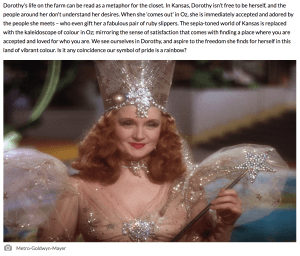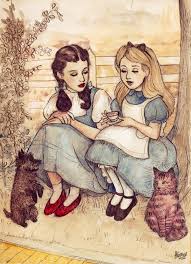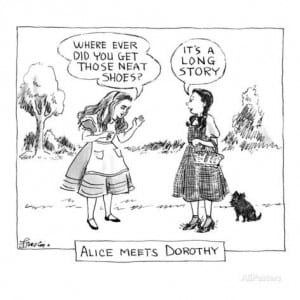A slight change in direction…
“Camp as defined by Babuscio, are the “elements in a person, situation or activity that express, or are created by a gay sensibility” (Adamson, 2015)
After presenting my ideas, it became evident that my original concept for this work had become lost, due to the changes that have been made. It was suggested that from the video footage that I presented, the ideas were quite provocative regarding ideas of sexuality. This sparked my interest because it reminded me of my initial reactions to Marina Abramovic’s work, which seem to have a similar provocative nature. Alli Maloney has said “Abramovic’s body is her medium and subject, and her work often reflects on gender sexuality and the tensions between male and female physicality and mind.” (2015)
In relation to this feedback, I began researching the characters of Alice from Alice in Wonderland and Dorothy from The Wizard of Oz. Both of these characters have been used as icons within the LGBT community. Although I do not identify within this group of people, it is a constant topic within our news currently, with the battle for equality and gay rights. Prior to my research, I was not aware that from around the time of World War II, to ask if someone was a ‘Friend of Dorothy’, was a covert way to ask someone’s sexual orientation, especially during this time in which homosexuality was unlawful in the United States. It is also not a coincidence that the flag for gay rights is a rainbow. Some have conspired that this is because of the famous song which Dorothy sings about wanting to fly beyond the rainbow.
The entire film can be read in relation to the struggle of the gay minority;
(Semple, 2015)
I regards to Alice in Wonderland, it has been said of the 2010 film “A young girl travelling to a fantasyland of colourful characters, villains, helpful allies, questions of morality, and a giant fancy dinner party? This is practically the gay rights struggle – and every seven-year-old gay boy’s dream world – packaged into a single big screen adventure.” (Queerty Staff, 2009).
This new research has lead me to a new concept. With the current politics of the World and its recent history, the oppression of the gay person is still a big issue. Therefore my new concept surrounds this. The costume will be a mixture of Alice and Dorothy, characters which have been illustrated together on several occasions, as two characters which is widely regarded within the LGBT community. The silks will represent the struggle that these people face. Trying to climb to reach the other side (of the rainbow) but being restricted along the way, which will be shown through the holds used within the aerial silks.
Although, the concept is mainly focused on this idea, and the concept may be clear to some, I feel like it could be taken in other ways by different people, depending on what journey they are facing and the struggles along the way. It has been said that people relate to fictional characters, even within their everyday life, often imagining how a character would react to a certain situation. “Nineteen per cent of those respondents said the voices of fictional characters stayed with them even when they weren’t reading, influencing the style and tone of their thoughts – or even speaking to them directly. For some participants it was as if a character “had started to narrate my world”, while others heard characters talking, or imagined them reacting to things going on in everyday life” (Lea, 2017) . Dorothy and Alice are two very popular characters, often imitated by people, both in fancy dress as well as fashion shoots, such as an Alice inspired dress created by Marks and Spencer and the headband that gained its name from the character. Marina Abramovic has stated the importance of appealing to a wide audience, by creating work with a multi-level approach, “Art is or has to be universal … [It] can’t just feminist, can’t just be political, can’t be just spiritual. The more elements that you have in your work, the longer that work lives because every society can take one layer at a time [that they] need at the moment.” (Abramovic in Maloney, 2015).



